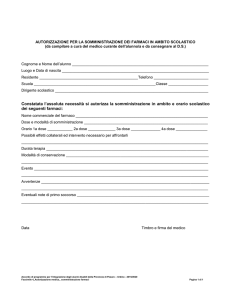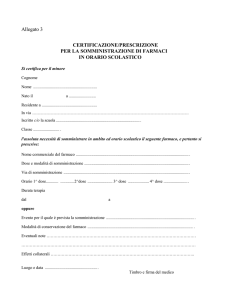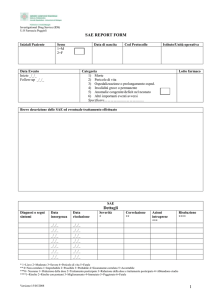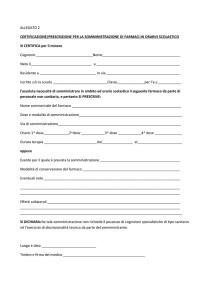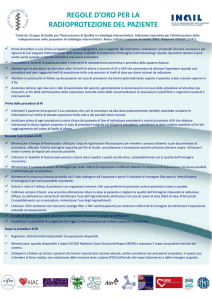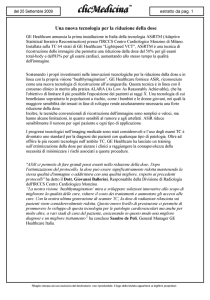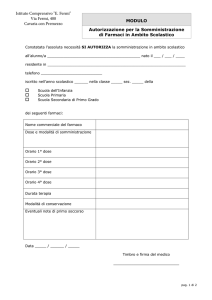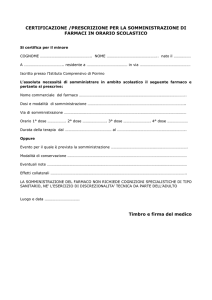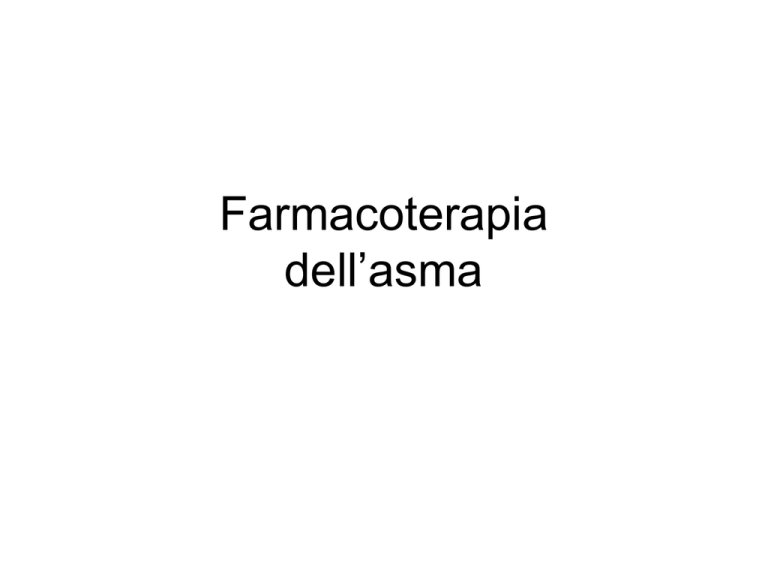
Farmacoterapia
dell’asma
Categories of Medications
• Long-term control (maintenance)
medications
– Corticosteroids
– Long-acting beta-agonists
– Leukotriene modifiers
– Cromolyn and nedocromil
– Methylxanthines
Categories of Medication
• Quick relief (rescue)
medications
–Short acting -2 agonists
–Anticholinergics
NAEPP (National Asthma educatio prevention program)
Classification of Asthma
Severity
4
3
2
1
Severe Persistent
Moderate Persistent
Mild Persistent
Mild Intermittent
E per le malattie broncopolmonari croniche ostruttive
(BPCO)
Modello concettuale della
immunopatogenesi dell’asma bronchiale
• Le IgE si legano ai mastociti nelle mucose delle vie
respiratorie che liberano istamina, triptasi, PGD2, LTC4
e PAF = broncocostrizione immediata e riduzione della
FEV1 (Forced Expiratory Volume one second – Volume
espiratorio massimo al secondo) . Inoltre si sintetizzano
e si rilasciano citochine, IL-4 e IL-5, TNF-a, GM-CSF,
(fattore stimolante le colonie granulocitariemacrofagiche), TGF (tissue growth factor), il LTB4. Le
citochine, il LTB4 ed il TNF-a inducono l’espressione di
molecole di adesione endoteliale (ICAM, VCAM),
richiamano e stimolano eosinofili e neutrofili che a loro
volta producono ECP (proteina cationica degli eosinofili)
e MBP (proteina basica maggiore), proteasi. Tali fattori
provocano edema, ipersecrezione mucosa, costrizione
della muscolatura liscia. Inoltre si ha la produzione di
ROS (NO, O2- e ONOO-), specie altamente ossidanti che
ulteriormente distruggono i tessuti circostanti. Inoltre…..
(Sintomatici)
(Modificatori malattia)
Barnes, Nature Reviews Drug Discovery 3; 831-844 (2004)
Treatment
• BronchodilatorsThere are three types of
bronchodilators used clinically:
• β2-agonists,
• anticholinergics
• methylxanthines.
These drugs relax the smooth muscles of the
airway allowing for improved airflow. Many
patients feel less breathless after taking
bronchodilators.
β2-agonisti
• ad azione rapida (salbutamolo,
terbutalina, fenoterolo, orciprenalina).
Onset: 5 min, durata: fino a 6 h
• protratta (salmeterolo, formoterolo)
Onset: 20-30 min, durata: fino a 12 h
• Si somministrano per via inalatoria
(topica) in sospensioni con particelle di
2-5 micron di diametro che
raggiungono facilmente i bronchi di
piccolo calibro
Historic
• Initially, subcutaneous injections of
epinephrine were used, followed by a
nebulized epinephrine solution.
• Epinephrine is one of the most potent
vasopressor (i.e. causes constriction of
the blood vessels and corresponding
rise in blood pressure) drugs known.
• Epinephrine affects respiration primarily
by relaxing the bronchial muscle.
• Epinephrine is rapidly metabolized by
COMT, primarily in the liver.
OH
OH
HO
NHMe
HO
NH2
HO
HO
Epinephrine
(Adrenaline)
Equal selectivity for
Both a and -receptors
Norepinephrine
(Noradrenaline)
Greater selectivity for
areceptors
Perhaps, still greater selectivity for -receptors could be
Generated by appending larger alkyl substituent on nitrogen
An improvement!
OH
HO
H
N
HO
Isoprenaline
• Isoprenaline was synthesized by
German chemists in the 1940’s
• It had less cardiovacular side effects
than adrenaline
• Became the most widely used inhaled
treatment for asthma for the next 20
years.
Further improvements
needed
• Needed an agent which was longer
lasting, more resistant to COMT
• Needed an agent which was more
selective for the 2 receptors in the lung
and less selective for the 1 receptors of
heart.
Arrives Salbutamol
OH
HOCH2
H
N
HO
Salbutamol
• Tert-butyl group renders salbutamol
more selective for 2
• Hydroxymethyl group (in place of OH)
renders salbutamol resistant to COMT
• Remains the most widely used antiasthma drug in the world
Salbutamol
• Salbutamol (INN) or albuterol (USAN) is a short-acting β2adrenergic receptor agonist used for the relief of bronchospasm
in conditions such as asthma and COPD.Salbutamol sulphate
is usually given by the inhaled route for direct effect on bronchial
smooth muscle. This is usually achieved through a metered
dose inhaler (MDI), nebuliser or other proprietary delivery
devices (e.g. Rotahaler or Autohaler). In these forms of delivery,
the effect of Salbutamol can take place within 5 to 20 minutes of
dosing. Salbutamol can also be given orally or intravenously.
However, some asthmatics may not respond to these
medications as they will not have the required DNA base
sequence in a specific gene.Salbutamol became available in the
United Kingdom in 1969 and in the United States in 1980 under
the trade name Ventolin.
(+)-DBTA Resolution: Harteley, et al16
Total yield of (+)-DBTA Resolution 30-40%. Greater
than 99.5% pure R-salbutamol The process is advantageous as
the process are short and efficient.
Optical resolution of racemic alcohols by diastereoisomeric
complex formation with O,O -dibenzoyl-(2R,3R)-tartaric
acid.
Short-acting -2 agonists
• Mechanisms
– -2 agonist effects (smooth
muscle
relaxation due to increased
cyclic
AMP)
– Repeated high dose exposure
to agonist leads to down
regulation of receptors
• Side effects
– Tachycardia
– Tremor
– Hypokalemia,
hypomagnesemia
– Increased lactic acid
– Hyperglycemia
ß2 Agonists
Short Acting (3-6 hr)
Dose/puff
Metoproterenol (Alupent, Metaprel)
650 mcg
Albuterol (Proventil, Ventolin)
90 mcg
Bitolterol (Tornalate)
370 mcg
Pirbuterol (Maxair)
200 mcg
Terbutaline (Brethaire)
200 mcg
Long Acting (12 hr +)
Salmeterol (Serevent)
Diskus)
Formoterol
21 mcg (50 mcg in
12 mcg
SAR 2- Agonisti
Albuterol
Metoproterenol
Bitolterol
Pirbuterol
Terbutaline
Oral β2 Agonists
• Less effective than inhaled beta
agonists
• Produce more adverse effects
• Have a slower onset of action
• Oral syrup may be useful for young
children and elderly with infrequent
mild symptoms who cannot use an
inhaler and spacer device
*Medical Letter Vol 42 Page 20
(R)-albuterol
Potent binding to the 2-receptor
++
Intracellular Ca ; Airway
reactivity
Eosinophil activation
Rapid metabolism
No effect on mucus production
Ciliary beat frequency &
mucocilary transport velocity
Very limited binding to b2- receptor
++
Intracellular Ca ;
Hyperresponsiveness
Eosinophil activation; Mast cell
histamine release
Metabolized at 1/10th the rate of (R)albuterol
Mucus production by epithelial cells
Ciliary beat frequency & mucociliary
transport velocity
(S)albuterol
Levalbuterol
“Levoalbuterol…appears to have NO
clinically significant advantage over
racemic albuterol” The Medical
Letter. Volume 41, Page 51.
“Levalbuterol, the R-isomer of
racemic albuterol, offers no
clinically significant advantage over
racemic albuterol” The Medical
Letter. Volume 42, Page 19.
Long-Acting Bronchodilators
Albuterol
(Proventil,
Ventolin)
Dose
Character
Onset of
action
Duration
Salmeterol
(Serevent)
Formoterol
(Foradil)
2-4 puffs prn 2p q12 (MDI)
1p q12
1p q12
(Diskus)
Hydrophilic
Lipophilic
Hydrophilic &
Lipophilic
Rapid
Delayed
Rapid
(2-5 minutes)
(>30
(2-5 minutes)
minutes)
Short
(4-6 hours)
Long
(12 hours)
Long
(12 hours)
Salmeterol
(Serevent)
• Long acting betaagonist/bronchodilator
• Binds to an exosite adjacent to the
regular beta receptor
• Slower onset of action
– maximum effect in 3 hours
• Longer duration of action (12 hours)
OH
HOCH2
H
N
O
HO
Salmeterol
Salmeterol is a long-acting beta2-adrenergic receptor agonist drug that is currently
prescribed for the treatment of asthma and chronic obstructive pulmonary disease
COPD. It is currently available in both dry-powder inhalers (DPIs) and pressurised
metered dose inhalers (pMDIs).
It is a long acting beta-adrenoceptor agonist (LABA), usually only prescribed for
severe persistent asthma following previous treatment with a short-acting beta
agonist such as salbutamol and is prescribed concurrently with a corticosteroid,
such as beclometasone. The primary noticeable difference of salmeterol to
salbutamol is that the duration of action lasts approximately 12 hours in
comparison with 4-6 hours of salbutamol.
10% lung deposition, 90% swallowed
CS-30
Chemical Structures
Formoterol
O
HN
O
HO
N
H
OH
Salmeterol
HO
HO
O
N
H
OH
CS-31
Exosite model proposed by johson et al.
CS-32
Diffusion microkinetic model
Salbutamolo
Formeterolo
Salmeterolo
Pharmacologic Differences:
β2 Receptor Binding for Formoterol Differs
From Salmeterol
Both
molecules bind to the β2 adrenergic
receptor active site, however
– Prolonged salmeterol activity depends on
binding with an exosite
– Prolonged activity of formoterol is
independent of exosite binding
Mutation
in the exosite region (Ile 164) could
affect duration of action of salmeterol
Green SA, et al. J Biol Chem. 1996;271:24029-24035.
CS-33
β2-agonisti: meccanismo
d’azione
β2-recettore
2-agonist
MLCK
phosphorylation
2-receptors
S. muscle
relaxation
Inhibition PI
hydrolysis
Sequestration of
intracellular
calcium
Calcium
extrusion
Activation of
calcium gated
potassium
channels
Inhibition
mediator
release
L’aumento del cAMP (β2-agonisti)
determina:
• Rilassamento bronchiale;
• Inibizione del release di mediatori
flogogeni dai mastociti/macrofagi;
• Aumento della clearence mucociliare
Catecolamine e recettori
• Recettori β-adrenergici
Cuore (β1 e β2)
Aumento frequenza, contrattilità e
velocità di conduzione
Rene ap. jux.-glom. (β1)
Aumento renina
Bronchi (β2)
Broncodilatazione
Muscolatura liscia vasale (β2)
Rilasciamento m. scheletrici, renali,
coronarie,
Pancreas (β2)
Aumento insulina
Fegato (β2)
Glicogenolisi, gluconeogenesi
T.adiposo (β3)
Catabolismo trigliceridi
α1
α2
β1
β2
β3
Adrenalina
++
++
+++
+++
+
α1
α2
β1
β2
β3
Noradrenalina
+++
++
++
+
+++
Effetti collaterali dei 2-agonisti
• Cardiocircolatori: tachicardia, aritmie,
alterazioni elettrocardiografiche,
ischemia miocardica, “myocardial
contraction band necrosis”
• Controndicati in pazienti cardiopatici:
può provocare aritmie e morte
• Neuromuscolari: tremori, agitazione,
insonnia
• Metabolici: iperglicemia, aumento degli
ac. grassi non esterificati, ipoK, ipoMg ed
ipoPO4, iperinsulinemia
Teofillina*
• La teofillina (1,3-dimetilxantina) è
metabolizzata ad ac. 1,3-dimetil urico dal
CYP1A2 (8-idrossilazione) e parzialmente
dal CYP2E1 a 1-metilxantina per 3demetilazione
*Si usa il sale di etilendiamina o aminofillina
Teofillina: meccanismo d’azione
Inibizione = accumulo di cAMP
Meccanismo d’azione della
teofillina
• Inibizione delle PDE ed accumulo di cAMP ;
• Antagonismo su recettori adenosinici (A1-,
A2A-, A2B-receptors)
• Aumento del rilascio di catecolamine
• Inibizione del rilascio di prostaglandine e
TNF-a
• Inibizione della traslocazione di NF-k B
• Aumento apoptosi
• Possibile diminuzione della trascrizione geni
proinfiammatori per interferenza con istone
deacetilase
Farmacocinetica della teofillina
1) Somministrazione per via orale (150mgx4 die)
e parenterale (e.v. 5 mg/kg per infusione lenta
fino a 25mg/min; i.m. e rettale);
2) Legame alle proteine plasmatiche 60%;
3) Metabolismo epatico (CYP 1A2) (variazioni
individuali);
4) Emivita: da 3,5 a 9h;
Toxicity
• Nausea, vomiting, diarrhea
• Irritability, insomnia
• Seizures, hyperthermia, brain
damage
• Hyperglycemia, hypokalemia,
hypotension, arrhythmias
• Must monitor levels
Effetti collaterali e tossici della
teofillina
(concentrazione ematica > 20 mg/l)
Nausea, vomito, cefalea, ipotensione,
brividi, palpitazioni, tachicardia,
convulsioni
In infusione rapida può provocare
aritmie e morte
Roflumilast (Daxas® )
•
Daxas, è il primo di una nuova classe di farmaci per il trattamento della
BPCO ed anche il primo trattamento antinfiammatorio specifico per la
BPCO.
•
Il farmaco è stato recentemente approvato dalla European Medicine Agency
(EMA), è già disponibile in Germania, Inghilterra e in altri Paesi europei, e
dovrebbe entrare in commercio a breve nella maggior parte degli altri Paesi
europei, compresa l’Italia.
•
Daxas® è indicato per la terapia di mantenimento della BPCO di grado
severo (FEV1 inferiore al 50% dopo broncodilatazione) associata a
bronchite cronica nei pazienti adulti con storia di frequenti riacutizzazioni, in
aggiunta al trattamento con broncodilatatori.
Meccanismo d’azione
•
•
•
Roflumilast è un inibitore della PDE4, un agente antinfiammatorio, nonsteroideo, studiato per attaccare sia l’infiammazione sistemica sia quella
polmonare associate alla BPCO. Il meccanismo d’azione è l’inibizione della
PDE4, il principale enzima responsabile del metabolismo dell’adenosin
monofosfato ciclico (cAMP) situato nelle cellule strutturali ed infiammatorie
importanti per la patogenesi della BPCO.
Roflumilast agisce sulle varianti strutturali 4B e 4D della PDE4A con una
potenza simile in un range nanomolare. L’affinità alle varianti strutturali
PDE4C è più bassa di 5-10 volte. Questo meccanismo d’azione e la
selettività si applicano anche a roflumilast N-ossido, che è il principale
metabolita attivo di roflumilast.
Roflumilast è estensivamente metabolizzato nell’uomo, con la formazione di
un metabolita principale farmacodinamicamente attivo, roflumilast N-ossido.
Poiché sia roflumilast che roflumilast N-ossido contribuiscono entrambi alla
attività inibitoria sulla PDE4 in vivo, le considerazioni farmacocinetiche sono
basate sull’attività inibitoria totale sulla PDE4 (cioè sulla esposizione totale
a roflumilast e a roflumilast N-ossido).
Anticolinergici correntemente
utilizzati
• Ipratropio bromuro
• Ossitropio bromuro
• Tiotropio bromuro*
* Farmaco a lunga durata di azione (1
sola somministrazione/die), in quanto
ha una dissociazione lenta dai recettori
muscarinici M1 e M3
12. Cholinergic Antagonists (Muscarinic receptor)
•
•
•
Drugs which bind to cholinergic receptor but do not activate it
Prevent acetylcholine from binding
Opposite clinical effect to agonists
Postsynaptic
nerve
Postsynaptic
nerve
Ach
Ach
Ach
Antagonist
©1
12. Cholinergic Antagonists (Muscarinic receptor)
Me
12.1 Atropine
N
easily racemised
H
CH2 OH
O
CH
C
*
O
•
•
•
•
•
Racemic form of hyoscyamine
Source - roots of belladonna (1831) (deadly nightshade)
Used as a poison
Used as a medicine
decreases GIT motility
antidote for anticholinesterase poisoning
dilation of eye pupils
CNS side effects - hallucinations
©1
12. Cholinergic Antagonists (Muscarinic receptor)
12.2 Hyoscine (scopolamine)
Me
N
H
O
CH2 OH
H
H
O
CH
C
*
O
•
•
•
Source - thorn apple
Medical use treatment of motion sickness
Used as a truth drug (CNS effects)
©1
12. Cholinergic Antagonists (Muscarinic receptor)
12.3 Comparison of atropine with acetylcholine
Me
N NMe3
CH2
CH
H2
CH2 OH
O
O
C
O
•
•
•
•
•
CH3
CH
C
O
Relative positions of ester and nitrogen similar in both molecules
Nitrogen in atropine is ionised
Amine and ester are important binding groups (ionic + H-bonds)
Aromatic ring of atropine is an extra binding group (vdW)
Atropine binds more strongly than acetylcholine
©1
12. Cholinergic Antagonists (Muscarinic receptor)
12.4 Analogues of atropine
Br
CH(CH3) 2
H 3C
N
H
CH2 OH
O
CH
C
O
Ipratropium
(bronchodilator & anti-asthmatic)
•
•
•
Analogues are fully ionised
Analogues unable to cross the blood brain barrier
No CNS side effects
©1
The combination preparation ipratropium/salbutamol is a formulation containing
ipratropium bromide and salbutamol sulfate (albuterol sulfate) used in the
management of chronic obstructive pulmonary disease (COPD) and asthma. It is
marketed by Boehringer Ingelheim as metered dose inhaler (MDI) and nebuliser
preparations under the trade name Combivent.
Medications commonly used in asthma and COPD (primarily R03) edit
Anticholinergics: Ipratropium, Tiotropium
Short acting β2-agonists: Salbutamol, Terbutaline
Long acting β2-agonists (LABA):
Bambuterol, Clenbuterol, Fenoterol,
Formoterol, Salmeterol
Corticosteroids: Beclometasone, Budesonide, Ciclesonide, Fluticasone
Leukotriene antagonists: Montelukast, Pranlukast, Zafirlukast
Xanthines:
Aminophylline, Theobromine, Theophylline
Mast cell stabilizers:
Cromoglicate, Nedocromil
Combination products:
Budesonide/formoterol, Fluticasone/salmeterol,
Ipratropium/salbutamol
©1
12. Cholinergic Antagonists (Muscarinic receptor)
12.6 SAR for Antagonists
R'
O
CH2
R 2N
CH2
R' = Aromatic or
Heteroaromatic
CH
C
R'
O
Important features
• Tertiary amine (ionised) or a quaternary nitrogen
• Aromatic ring
• Ester
• N-Alkyl groups (R) can be larger than methyl (unlike agonists)
• Large branched acyl group
• R’ = aromatic or heteroaromatic ring
• Branching of aromatic/heteroaromatic rings is important
©1
Anticolinergici correntemente
utilizzati
• Queste molecole sono usate per uso
topico inalatorio
• Escrete immodificate nelle feci
• Gli effetti collaterali sistemici sono
scarsi; si può avere secchezza delle
fauci.
• Meno efficaci dei 2-agonisti a cui
possono essere associati; attivi su
sottogruppi di pazienti asmatici,
efficacia ridotta nel trattamento
cronico.
• Usati anche nel trattamento dell’attacco
Combivent
• Ipratropium/Albuterol
• Indicated for COPD for patients
who were not controlled with
single therapy
• Not FDA approved for use in
asthma
• Contraindicated with soy allergy
– Some dosage forms may contain
soya lecithin
Tiotropio RESPIMAT®
Tiotropio RESPIMAT® 2,5 microgrammi (dose totale 5
microgrammi in 2 erogazioni da 2,5 microgrammi una
volta al giorno) ha un effetto terapeutico paragonabile
a tiotropio HandiHaler® 18 microgrammi9.
RESPIMAT® è un dispositivo pratico da usare, multi
dose, con indicatore di dosaggio, che contiene una
quantità di farmaco sufficiente per un mese di terapia.
*Tiotropio è commercializzato con il nome
commerciale di SPIRIVA®.
*Inalatore Predosato a Idrofluoroalcano, Turbohaler®,
Diskus®
Tecnologia avanzata; facilità d'uso
Per utilizzare tiotropio RESPIMAT® il paziente deve semplicemente girare la base
dell'inalatore di 180 gradi. Con questa operazione viene compressa la molla che
provvederà a far salire la dose prestabilita del principio attivo nel tubo capillare e di qui
a una micro pompa. L'inalatore che eroga la fine nebulizzazione Soft Mist™ è stato
realizzato applicando i principi d'uso consolidato nella tecnologia dei microchip.
Leukotriene Modifiers
Leukotriene Modifiers
• Leukotrienes are one of many
mediators active in patients with
asthma
• Cysteinyl LT’s have major role in
asthma
– Bronchoconstriction
– Airway hyperresponsiveness
– Vascular permeability
– Increased mucous production
• LTB4 less well understood
– Neutrophil chemoattractant
Leukotriene Modifiers
• Zileuton (Zyflo)
– Inhibits 5-lipoxygenase
– Blocks production of all leukotrienes
• Zafirlukast (Accolate)
– Leukotriene receptor antagonist
– Blocks only effects of LTC4, D4, E4
• Montelukast (Singulair)
– Newest agent
– Also leukotriene receptor antagonist
5-LO
inhibitors
- zileuton
Cysteinyl-LT
receptor
antagonists
- zafirlukast
montelukast
Clinical Effects
• Increase in FEV1 by 10-15%
• Reduces
– Beta-agonist use
– Daytime and nocturnal symptoms
• Often used in combination with
inhaled steroids
– Potentially first-line in mild asthma
– Consider in mild asthma and allergic
rhinitis
• Treatment of choice in aspirin-
Montelukast (Singulair)
• Dosing:
– ages 15 & older: 10 mg po daily
– ages 6-14: 5 mg chewable dose
daily
– ages 2-5: 4 mg chewable dose
daily
• Recommended to take dose in
the evening
• Can be taken with or without
Montelukast
CO2Et
CO2Et
OH
1.LiAlH4
2.CH2N2
2.NaCN, DMSO
2.benzoyl chloride
in pyridine
OMs
COOMe
Cl
NH2NH2
SAc
OH
OTHP
CO2Me
N
OTHP
Cs2CO3
S
SH
Cl
N
CO2Na
OH
S
1. PPTS/ MeOH
2. LiOH/ THF-H2O
3. NaOH/ EtOH
Cl
1.MsCl/ Et3N
2.AcSCs, DMF
OBz
OBz
COOMe
COOMe
1. KOH/ EtOH-H2O
CN
1.MsCl, Et3N
N
CysLTs-receptor antagonists
LTD4
Pranlukast
Zafirlukast
Montelukast
Zileuton (Zyflo)
• 600 mg po four times a day
• Drug interactions
– Theophylline, propranolol, warfarin
• Monitor hepatic function
– Every month x 3 months
– Then every 3-4 months
• Can take without regard to meals
• Approved for use down to age
12
Zafirlukast (Accolate)
• 20 mg po BID
• Drug interactions
– Warfarin, aspirin, theophylline,
erythromycin
• Rare hepatic events reported
• Rare cases of Churg-Strauss
• Absorbed poorly with food
– Take 1 hour pre- or 2 hours postmeals
• Approved for use down to age
12
Effetti collaterali degli
antileucotrienici
• Alcuni soggetti trattati hanno sviluppato la
sindrome di Churg-Strauss (vasculite
sistemica, eosinofilia, sinusite e rinite),
probabilmente indotta dalla riduzione della
dose di glucocorticoidi
• Alcuni casi di epatopatie con alterazione
dei parametri ematici con zafirlukast
Cromoni
• “Stabilizzazione” della membrana dei
mastociti/macrofagi con inibizione del
rilascio di mediatori flogogeni, inibizione
della produzione di IgE, inibizione delle
fibre C (neuroni sensori), forse mediata
da inibizione canali del cloro espressi
nei neuroni sensori
• Sono utilizzati nella profilassi per la
terapia dell’asma bronchiale. Non
hanno attività broncodilatatoria.
• Si somministrano per via inalatoria
Inibitori della liberazione di
mediatori chimici
Cromolyn sodium
Nedocromil
Last reviewed on RxList: 7/29/2008
Tilade® Inhaler
(nedocromil sodium) Inhalation
Aerosol
Tilade (nedocromil sodium) is an inhaled anti-inflammatory agent for the preventive management of
asthma. Nedocromil sodium is a pyranoquinoline with the chemical name 4H-Pyrano[3,2g]quinoline-2,8-dicarboxylic acid, 9-ethyl-6,9-dihydro-4,6-dioxo-10-propyl-, disodium salt, and it
has a molecular weight of 415.3. The empirical formula is C19H15NNa2O7. Nedocromil sodium, a
yellow powder, is soluble in water.
The molecular structure of nedocromil sodium is:
Chemical Class: Pyranoquinoline
Tilade Inhaler (nedocromil sodium inhalation aerosol) is a pressurized metered-dose aerosol
suspension for oral inhalation containing micronized nedocromil sodium and sorbitan trioleate, as well
as dichlorotetrafluoroethane and dichlorodifluoromethane as propellants. Each Tilade canister contains
210 mg nedocromil sodium. Each actuation meters 2.00 mg nedocromil sodium from the valve and
delivers 1.75 mg nedocromil sodium from the mouthpiece. Each 16.2 g canister provides at least 104
metered actuations. After 104 metered actuations, the amount delivered per actuation may not be
consistent and the unit should be discarded.
Each Tilade Inhaler canister must be primed with 3 actuations prior to the first use. If a canister
remains unused for more than 7 days, then it should be reprimed with 3 actuations.
Cromolyn sodium
and Nedocromil
• Block chloride channel of mast
cells
– Mast cell stabilizers
– Decrease histamine release
• Inhibit neutrophil chemotaxis
• Nedocromil also inhibits
eosinophil degranulation
Barnes, Nat Rev Drug Discov. 3:831-844, 2004
CILOMILAST
Cilomilast (ARIFLO) is a drug which was developed for the treatment of respiratory disorders
such as asthma and Chronic Obstructive Pulmonary Disease (COPD). It is orally active and acts as a
selective Phosphodiesterase-4 inhibitor.
Phosphodiesterase (PDE) inhibitors, such as theophylline, have been used to treat Chronic
Obstructive Pulmonary Disease (COPD) for centuries; however, the clinical benefits of these agents
have never been shown to out-weigh the risks of their numerous adverse effects. Four clinical trials
were identified evaluating the efficacy of cilomilast, the usual randomized, double-blind, and
placebo-controlled protocols were used. It showed reasonable efficacy for treating COPD, but side
effects were problematic and it is unclear whether cilomalast will be marketed, or merely used in the
development of newer drugs.
Cilomilast is a second-generation PDE4 inhibitor with antiinflammatory effects that target
bronchoconstriction, mucus hypersecretion, and airway remodeling associated with COPD.
ARIFLO
•
•
GlaxoSmithKline filed for drug approval with the US FDA at the end of 2002
and in January 2003 with the European Medicines Evaluation Agency
(EMEA). In October 2003 the FDA issued an approvable letter for use of
Ariflo in maintenance of lung function in COPD patients poorly responsive to
salbutamol, despite an earlier decision by the FDA advisory panel to reject
approval.
Before issuing final approval, however, the FDA has requested additional
efficacy and safety data. This is likely to focus on sustainability of clinical
benefits and safety of Ariflo in long-term use.
Asthma Treatment
Summary
Mild Intermittent
Use: Albuterol, Asthma Action Plan
Mild Persistent
Use: Albuterol and Controller medications (low dose steroids,
nedocromil, cromolyn, montelukast)
Moderate Persistent
Use: Combination of medications (low to medium dose
steroid plus long acting beta agonist, and/or Leukotriene
modifiers)
Severe Persistent
Use: High dose inhaled steroids, long acting beta agonist, and
leukotriene modifier. May need oral steroids
Cellular effect of corticosteroids, Barnes et al., Ann. Int. Med., 139, 359-370, 2003
Structure/activity relationships
• Functional groups essential for and which delineate
aldosterone or cortisol activity:
• double bond at D4
• C3 ketone
• C20 ketone
Structure/activity relationships
•
•
•
•
•
Functional groups essential for glucocorticoid activity:
C21 hydroxyl
C11 ketone or hydroxyl
In vivo, C11 ketone gets reduced to b-hydroxyl group. This is the reason
why cortisone is active as an antiinflammatory agent).
For glucocorticoids, the C17 a-hydroxyl group enhances activity, but is not
essential. For example, corticosterone is active but lacks a C17 hydroxyl
group.
Steroid analogs with antiinflammatory
activity
•
•
•
Add fluorine to C9. 9-a-fluorocortisol has 10 times more activity compared to the
parent cortisol. However, it also has 125 times the mineralcorticoid activity, so
considerable specificity is lost!
Add double bond at C1. Prednisolone (1,2-dehydrocortisol) and prednisone (1,2dehydrocortisone) are five times more active than their parent compounds cortisol
and cortisone, respectively, without changing mineralcorticoid activity.
Add a C16 methyl group. A methyl group added to either the a or b face increases
glucocorticoid activity and decreases mineralcorticoid activity for overall increased
selectivity.
Combinations of modifications which
optimize antiinflammatory activity
•
Betamethasone has 25 times and dexamethasone has 30 times the activity
of cortisol. Triamcinolone, with a hydroxyl instead of a methyl group, has a
shorter duration of action than betamethasone and dexamethasone, but is
roughly as potent. None have mineralcorticoid activity.
http://www.neurosci.pharm.utoledo.edu/MBC3320/glucocorticoids.htm
CORTICOSTEROIDI USATI NEI
NUOVI DISPOSITIVI
Budesonide
Mometasone
Fluticasone
Ciclesonide
Glucocorticoidi: effetti collateri della terapia
a lungo termine
• Obesità e ridistribuzione del grasso nell’organismo
(”buffalo hump, “moon facies”, area sopraclavicolare, strie
addominali);
• Riduzione dello spessore ed atrofia della cute con
difficoltà nella cicatrizzazione delle ferite;
• Riduzione delle masse muscolari e miopatie;
• Osteoporosi (inibizione osteoblasti, diminuito
assorbimento calcio ed aumento PTH, attivazione
osteoclasti indiretta, difetti nella mineralizzazione),
osteonecrosi;
• Modificazioni dell’umore (euforia e psicosi);
• Cateratta, glaucoma;
Glucocorticoidi: effetti collaterali della
terapia a lungo termine (segue)
• Immunosoppressione con diminuzione delle difese
naturali contro le infezioni;
• Ritenzione idrosalina ed ipertensione (per effetto
mineralcorticoide di alcune molecole ed aumento epatico
della sintesi di angiotensinogeno ed aumento delle
risposte pressorie catecolaminergiche );
• Ritardo della crescita nei bambini;
• Dopo trattamento prolungato, inibizione e soppressione
dell’asse ipotalamo-ipofisi-surrene ed atrofia surrenalica.
L’interruzione della somministrazione deve avvenire
gradualmente;
• Ulcere peptiche;
• Iperglicemia e diabete mellito iatrogeno;
Clinical Effects
• Corticosteroids are the most effective
treatment for long term control of
asthma
– Reduce symptoms
– Decrease use of bronchodilators
– Improve peak flows
– Decrease exacerbations
• Let’s look at some examples of existing
data
Clinical Effectiveness
1.0
0.8
0.6
(max=6)
Asthma Severity Score
Placebo
0.4
Inhaled Steroid
0.2
0
3
6
9
12
Time (Months)
Juniper et al., Am Rev Resp Dis, 1990
Clinical Effectiveness
3.0
Placebo
2.0
(puffs/day)
Bronchodilator Use
2.5
1.5
1.0
0.5
Inhaled Bronchodilatator
0
3
6
9
12
Time (Months)
Juniper et al., Am Rev Resp Dis, 1990
Mechanism of Action
• Inhibit production of inflammatory
cytokines
• Decrease number of eosinophils &
mast cells
• Decrease mucous secretion
• Increase synthesis of ß-2 receptors
Important with concomitant beta-agonist use
Effects of Inhaled
Corticosteroids on
Inflammation
Compromised
Epithelium
Intact
Epithelium
Thickened BM
Inflammatory Cells
Inflammatory
Cells
Laitinen et al. J Allergy Clin Immunol 1992;90:32-42
Adverse Effects
• Oral candidiasis (thrush)
• Dysphonia
• Systemic effects at high doses
– Potential for pituitary-adrenal axis
suppression
– Osteoporosis/osteopenia
– Growth rate suppression in children
Oral Candidiasis
•
•
•
•
Related to total dose
Incidence 5 - 10%
Spacer reduces incidence
Mouth washing helpful
– Good recommendation: Use ICS
before brushing teeth
• Twice a day
• Mouth gets rinsed after use
Dysphonia
• Occurs in 30-50%
• Related to total dose
• Laryngeal myopathy
– May diagnose by rhinoscopy
• Spacers do not reduce incidence
• Maybe less common with dry powder
inhalers
Pituitary-Adrenal Axis
Suppression
• Marked variability from patient to patient
• Cumulative dose (inhaled, nasal, oral) important
– Probably not clinically significant
• No current recommendation for monitoring
– Some check annual morning serum cortisol for
patients on higher total doses (>1500mcg/day)
• Rare case reports of adrenal crisis in children
• No case reports in adults
Pituitary-Adrenal Axis
Suppression
• Doses of 1500-2000 mcg more
frequently associated with suppression
– Most studies looks at urinary cortisol
– Clinical significance
• Daily doses of 1500 mcg in adults and
400 mcg in children show little
suppression
• Budesonide 800 mcg/d and flunisolide
or triamcinolone up to 1000 mcg/d
caused no suppression in children
• May be caused by lower doses of
fluticasone than other inhaled steroids
Osteoporosis
• Risk is not clear
– CAMP study: children – no effect on
BMD
– NEJM 2001: adult women – decreased
BMD in hip but no spine or femoral
neck - ? significance
• Consider in all patients
– Calcium daily: 1000 – 1500 mg/d
– Vitamin D daily – 400-800 IU/d
– Weight bearing exercise
• High dose inhaled or oral steroids
– Bone density study
– Specific osteoporosis therapy
Effects on Growth
• Some studies have shown an effect on
short-term growth
– Short-term growth in children is highly
variable
– Approx. 1 cm/year less in some studies
• Some evidence that bone age is also
delayed proportionately
– Final height attained more relevant end-point
– Long-term studies to date show no effect on
adult height
Oral Bioavailability
• Majority of systemic activity comes
from steroid that enters the GI tract
• 10-20% of MDI dose reaches the lungs
• 80-90% of dose is swallowed
• Spacer device increases the amount of
steroid that reaches the lungs
– Less available for systemic activity
Triamcinolone - Azmacort
• Low dose
• Need to take 4 times a day
Fluticasone/Salmeterol DPI
(Advair)
• Proven as effective as combination
therapy with separate flovent and
serevent inhalers
• Improves compliance
– Only one inhalation twice a day
required
• Diskus dry powder inhaler
– Must instruct on delivery technique
– Shows number of remaining doses
Patogenesi
ASMA
BPCO
Allergeni
Fumo di sigaretta
Infiammazione bronchiale
Linfociti T CD4+
Eosinofili
Infiammazione bronchiale
Linfociti T CD8+
Macrofagi, neutrofili
REVERSIBILE
RIDUZIONE DEL FLUSSO
AEREO ESPIRATORIO
IRREVERSIBILE
BPCO fumatore: TERAPIA
• La disassuefazione dal fumo di tabacco è prioritaria e
deve essere indicata al primo posto nella terapia
consigliata
• Al BPCO fumatore motivato a smettere deve essere
sempre offerta la possibilità di accedere agli interventi
per il trattamento del tabagismo che si sono dimostrati di
maggiore efficacia ( counseling intensivo associato a
terapia farmacologica), anche ricorrendo agli ambulatori
specialistici per la prevenzione e il trattamento del
tabagismo ( Centri Antifumo)
Trattamento della BPCO
Riduzione dei fattori di rischio
• Sono disponibili diverse terapie farmacologiche efficaci ed
almeno una di queste dovrebbe essere somministrata in
aggiunta ai consigli pratici se necessario ed in assenza di
controindicazioni.
• Sono considerati di prima scelta i seguenti farmaci: terapia
sostitutiva nicotinica, bupropione a lento rilascio e
vareniclina.
il fumo di tabacco: aerosol di sostanze nocive:
idrocarburi aromatici policiclici,
nitrosamine, -benzopirene
sost. cancerogene
benzoantracene
HCN, CH3CHO ,
CH2O, NH3
sost. irritanti
CO lega l'emoglobina (=> carbossiemoglobina)
Dipendenza
e
Assuefazione
NICOTINA
Aspirata, tramite il circolo ematico, giunge al sistema nervoso, data
la sua capacità di attraversare la barriera ematoencefalica
Nel brain attiva i recett. acetilcolinergici nicotinici sui corpi cellulari
dopaminici dell'Area Ventro-tegmentale e terminali dopaminici del
Nucleo Accumbens e stimola la produzione di dopamina a livello
della corteccia frontale
Inibisce la MAO responsabile della degradazione
neurotrasmettitori monoamminergici (Dopa)
Azione periferica:
Rilascio di Adrenalina dalle ghiandole surrenali
Riduzione dei livelli di insulina
Iperglicemia
Metabolismo accelerato
Terapia sostitutiva con nicotina
TIPO
DISP.
DOS.
GOMMA
automed.
2-4 mg
CEROTTO
automed.
5 (7) mg
10 (14) mg
15 (21) mg
INALATORE automed.
CPR (subl/menta) automed.
10 mg
2 mg
BUPROPIONE
•
Il Bupropione, conosciuto anche con i nomi commerciali di Zyban,
Wellbutrin, Elontril, è un antidepressivo atipico, di recente
commercializzazione in Italia, che agisce inibendo la ricaptazione della
dopamina e della noradrenalina. È stato altresì utilizzato, in passato e
soprattutto in altri paesi, come molecola antagonista della nicotina; lo scopo
principale per il quale tale farmaco è stato studiato e introdotto, riguarda in
ogni caso il trattamento della depressione.
•
La sintesi di questa molecola avvenne nel 1966; tuttavia la sua
registrazione avvenne nel 1974, a cura dell'attuale GlaxoSmithKline
il farmaco è stato approvato anche come supporto nella terapia per
interrompere la dipendenza dal fumo a partire dal 2006, solo dal 2008 si è
avviata la diffusione del farmaco sotto copertura totale del SSN.
•
Trattamento della BPCO
Riduzione dei fattori di rischio
•
Fra i nuovi farmaci, la vareniclina potrebbe
avere un effetto terapeutico aggiuntivo
rispetto
alle
terapie
farmacologiche
attualmente disponibili nel promuovere
la cessazione della abitudine al fumo.
•
Una recente metanalisi ha evidenziato che la
vareniclina aumenta la probabilità di smettere
di fumare di circa tre volte rispetto al placebo
(astinenza continua a 12 mesi OR 3.22 ( CI
95% 2.43-4.27)
( K. Cahill, LF Stead, T. Lancaster Nicotine receptor partial agonists for smoking
cessation Cochrane Database of Systematic Reviews 2007 , Issue 1. ArtNo:CD006103)
VARENICLINA
E’ un’alternativa del bupropione (zyban) e delle terapie di rimpiazzo
nicotinico (NTR) ad esempio cerotti di nicotina, gomme l'inhaler e
compresse sublinguali
Caratteristiche
agonista parziale del sottotipo a42 del recett. nicotinico per l’Ach
Nome IUPAC: 7,8,9,10-tetrahydro-6,10-methano-6H-pyrazino
[2,3h][3]benzazepine,(2R,3R)-2,3-dihydroxibutanedioate (1:1)
Citisina
Vareniclina
L’approvazione definitiva del FDA è giunta l’11 maggio 2006
L’unico “anti-fumo” non nicotinico
•
•
quando la V. fitta con il recett. stimola il rilascio di dopamina,
sebbene produca un effetto più lento ma più duraturo rispetto
alla nicotina.
Inoltre V. parzialmente lo blocca (perché agonista “parziale”),
riduce il sito di binding disponibile per la nicotina, e qualora il
paziente dovesse fumare durante il trattamento, darebbe una
risposta meno efficace e il fumo risulterebbe sgradevole
• poiché la V ha una affinità maggiore
per i recett. Acetilcolinici-nicotinici
spiazza la nicotina dal recettore, come
il monossido di carbonio spiazza
l’ossigeno dall’emoglobina, pertanto
limita l’effetto della nicotina.
• Non ha un effetto forte come la
nicotina nel rilascio di dopamina, quindi
il potenziale di assuefazione risulta
minore
• La dose standard è 1 mg 2 volte al gg, con variazioni permesse
dalla FDA, che ne ha approvato l’uso per 2 settimane; se il
paziente smette di fumare, la somministrazione va continuata per
altre 12 settimane.
• V non è stata testata in adolescenti (under18) e nemmeno in donne
in attesa, pertanto non è raccomandato l’uso in questi soggetti.
Donne in allattamento devono evitare questo prodotto, in quanto
la v potrebbe fluire nel latte materno, portando ad effetti
sconosciuti sul bambino
Effetti collaterali del Chantix
• Nausea
• headache
• Vomiting
• Flautulence
• Insomnia (30%)
• Abnormal dreams
• Dysgeusia (alteration in
•
•
taste)
Epidermal Rash
Dry mouth
SINTESI VARENICLINA

